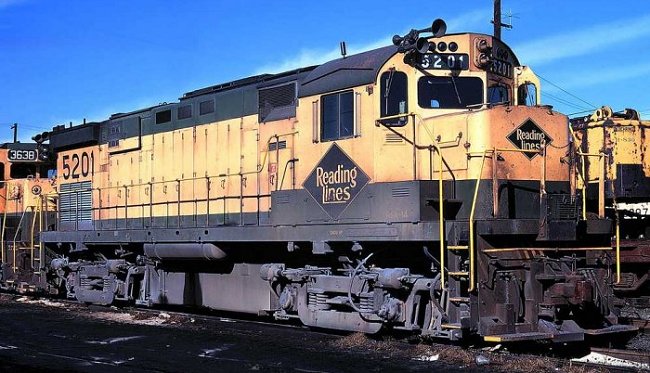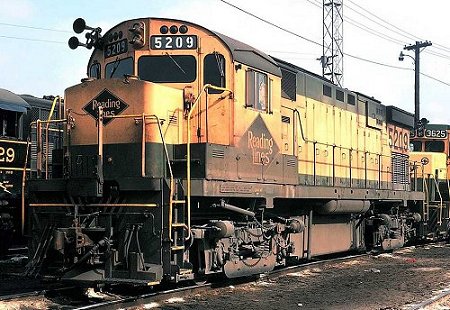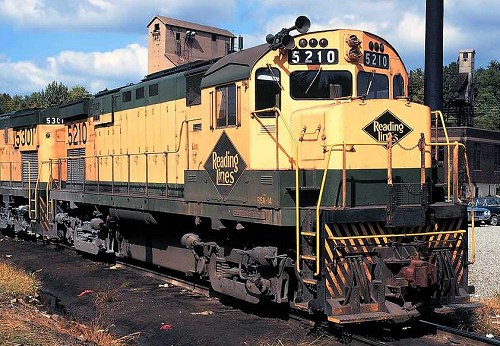Alco: Century 424

 In October and November 1963, the Reading took delivery of ten Alco Century 424 locomotives numbered 5201 - 5210. The railroad financed the acquisition of these 4-axle, 2400 horsepower units through trading in the remaining Alco FA/FB cab units on the roster. The Reading originally explored purchasing additional EMD GP-30 locomotives instead of the C424s, but decided against it when Alco offered more favorable terms on the trade in of the old units.
In October and November 1963, the Reading took delivery of ten Alco Century 424 locomotives numbered 5201 - 5210. The railroad financed the acquisition of these 4-axle, 2400 horsepower units through trading in the remaining Alco FA/FB cab units on the roster. The Reading originally explored purchasing additional EMD GP-30 locomotives instead of the C424s, but decided against it when Alco offered more favorable terms on the trade in of the old units.
Once in service, the C424s could be found all over the Reading system in both main and branchline service. Due to their weight, they did not operate on the Bloomsburg, Kentmere, Princeton Traction, Venice, and Broad/Callowhill Branches. Given their higher horsepower, two C424s could do the work of 3 Alco RS3s. These units could be seen operating alone in branchline service, or mated with other 4 or 6-axle units on mainline trains. In an interesting side note, the C424s' strong performance on the Reading was what prompted the Belt Railway of Chicago to purchase their own fleet of these units, after requesting cost and reliability info from the Reading. From a reliability standpoint, these units compared very favorably with the GP30 and GP35 units. Ther versatility and reliability led to their being the only second-generation Alcos that remained in service during the downturn in traffic in 1975, when the other Alcos on the roster were stored at Reading and Rutherford.
MODELING NOTES: The Reading's C424s have a few unique features that must be remembers when modeling one of these units. First, they have dual sand fills on the short hood, as the Reading desired additional sand capacity. Next, they have the squared-off fuel tank, instead of the rounded fuel tank of the C430 and C630 units. Finally, the Reading's C424s had the protruding rear numberboards/vents, as opposed to the recessed components on the C430s and C630s. Compare these photos with the other Alco units to see the difference. In addition to these spotting features, the photos also are a guide to placement of details such as the horn and antenna, as well as the unique shape of the pilot. When painting and lettering your models, take note of the occasional difference in the style of numbers in the numberboards, as can be seen in the above photo of #5203. Operationally, these locomotives could be used on any mainline or branchline (with the exceptions noted in the text), in any type of service. Their rounded cab and unique profile make them an interesting visual contrast to the Reading's EMD locomotives.

Did You Know?
Downloads
 A variety of Reading Company operations related documents, etc. that may be of use in your modeling efforts.
A variety of Reading Company operations related documents, etc. that may be of use in your modeling efforts.
 A variety of Reading Company operations paperwork, such as train orders, clearance forms, etc. that will help you operate your Reading layout in a prototypical manner.
A variety of Reading Company operations paperwork, such as train orders, clearance forms, etc. that will help you operate your Reading layout in a prototypical manner.
 Public Timetables, Employe Timetables, and Rulebooks that provide much useful operational information.
Public Timetables, Employe Timetables, and Rulebooks that provide much useful operational information.
 Signs, billboards, and other FREE goodies for your use. We ask only that you help spread the word about The Reading Modeler!
Signs, billboards, and other FREE goodies for your use. We ask only that you help spread the word about The Reading Modeler!

